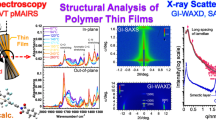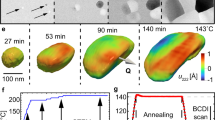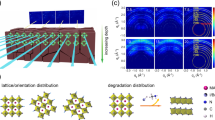Abstract
The quantitative estimation of stereoscopic molecular orientations in semicrystalline polymer thin films with characteristic heterogeneous structures is essential for the development of advanced film materials. Grazing-incidence X-ray diffraction (GI-XRD) is a powerful technique used to evaluate the orientational order of crystalline lattices; however, it provides the orientational order of only ordered regions (crystal and glassy liquid crystal regions). In contrast, infrared (IR) p-polarized multiple-angle incidence resolution spectrometry (pMAIRS) can provide the averaged orientational order of overall regions in a film regardless of sample crystallinity. This paper combines variable-temperature (VT) pMAIRS, static GI-XRD and spectroscopic ellipsometry and reports general insight into the molecular orientation mechanism occurring in polymer films revealed through the precise analysis of the structural evolution of linear poly(amic n-alkyl ester), PAE, with different lengths of n-alkyl chains during thermal curing, which involves solvent evaporation and dehydration imidization reactions to form the corresponding polyimide (PI). This combined method clarified that the PAE and PI thin films had a heterogeneous structure consisting of a glassy liquid-crystalline (ordered) region and a nonoriented amorphous region. Furthermore, imidization proceeded faster in the amorphous region than in the ordered (oriented) region. In addition, anomalies of refractive index and birefringence were found by comparing pMAIRS and spectroscopic ellipsometry, although the effect of the side chain length on the molecular orientation of PI was insignificant. The anomalies indicate that an isotropic void structures were generated by the elimination reaction of the side chains and that the volume fraction of voids increased with increasing side chain length. These results demonstrated that the combination of VT-pMAIRS and GI-XRD is a very powerful tool for the in situ structural analyses of noncrystalline (disordered crystal, glassy liquid crystal, and oriented amorphous) thin-film materials ongoing chemical reactions in their components and is inherently applicable to all kinds of interesting polymeric thin-film materials.
This is a preview of subscription content, access via your institution
Access options
Subscribe to this journal
Receive 12 print issues and online access
$259.00 per year
only $21.58 per issue
Buy this article
- Purchase on Springer Link
- Instant access to full article PDF
Prices may be subject to local taxes which are calculated during checkout














Similar content being viewed by others
References
Castellano JA. Surface anchoring of liquid crystal molecules on various substrates. Mol Cryst Liq Cryst. 1983;94:33–41.
Lee K-W, Paek S-H, Lien A, Durning C, Fukuro H. Microscopic molecular reorientation of alignment layer polymer surfaces induced by rubbing and its effects on LC pretilt angles. Macromolecules. 1996;29:8894–9.
Hasegawa, T. In: Ogawa S, editor. Organic electronics materials and devices. Japan: Springer; 2015. p. 1–41. https://doi.org/10.1007/978-4-431-55654-1
Zaumseil J. P3HT and other polythiophene field-effect transistors. Adv Polym Sci. 2014;265:107–38.
Lin L, Bidstrup SA. Processing effects on optical anisotropy in spin‐coated polyimide films. J Appl Polym Sci. 1993;49:1277–89.
Koynov K, Bahtiar A, Ahn T, Cordeiro RM, Hörhold HH, Bubeck C. Molecular weight dependence of chain orientation and optical constants of thin films of the conjugated polymer MEH-PPV. Macromolecules. 2006;39:8692–8.
Ree M, Chu CW, Goldberg MJ. Influences of chain rigidity, in-plane orientation, and thickness on residual stress of polymer films. J Appl Phys. 1994;75:1410–9.
van Aerle NAJM, Tol AJW. Molecular orientation in rubbed polyimide alignment layers used for liquid-crystal displays. Macromolecules. 1994;27:6520–6.
Shirota K, Ishikawa K, Takezoe H, Fukuda A, Shibasaki T. Surface orientation of polyimide alignment layer studied by optical second-harmonic generation. Jpn J Appl Phys 1995;34:L316–L319.
Sakai T, Ishikawa K, Takezoe H, Matsuie N, Yamamoto Y, Ishii H, et al. Surface orientation of main and side chains of polyimide alignment layer studied by near-edge X-ray absorption fine structure spectroscopy. J Phys Chem B. 2001;105:9191–5.
Ma J, Hashimoto K, Koganezawa T, Tajima K. End-on orientation of semiconducting polymers in thin films induced by surface segregation of fluoroalkyl chains. J Am Chem Soc. 2013;135:9644–7.
Cataldi P, Bayer IS, Cingolani R, Marras S, Chellali R, Athanassiou A. A thermochromic superhydrophobic surface. Sci Rep. 2016;6:1–11.
Aryal M, Trivedi K, Hu W. Nano-confinement induced chain alignment in ordered P3HT nanostructures defined by nanoimprint lithography. ACS Nano. 2009;3:3085–90.
Aasmundtveit KE, Samuelsen EJ, Guldstein M, Steinsland C, Flornes O, Fagermo C, et al. Structural anisotropy of poly(alkylthiophene) films. Macromolecules. 2000;33:3120–7.
Acharya BR, Kang SW, Kumar S. X-ray diffraction from the uniaxial and biaxial nematic phases of bent-core mesogens. Liq Cryst. 2008;35:109–18.
Francescangeli O, Samulski ET. Insights into the cybotactic nematic phase of bent-core molecules. Soft Matter. 2010;6:2413–20.
Acharya BR, Primak A, Kumar S. Biaxial nematic phase in bent-core thermotropic mesogens. Phys Rev Lett. 2004;92:1–4.
Hasegawa T. A novel measurement technique of pure out-of-plane vibrational modes in thin films on a nonmetallic material with no polarizer. J Phys Chem B. 2002;106:4112–5.
Hasegawa, T. Quantitative infrared spectroscopy for understanding of a condensed matter. Japan: Springer: 2017. p. 170–83. https://doi.org/10.1007/978-4-431-56493-5
Hada M, Shioya N, Shimoaka T, Eda K, Hada M, Hasegawa T. Comprehensive understanding of structure-controlling factors of a zinc tetraphenylporphyrin thin film using pMAIRS and GIXD techniques. Chemistry. 2016;22:16539–46.
Shioya N, Shimoaka T, Eda K, Hasegawa T. Controlling mechanism of molecular orientation of poly(3-alkylthiophene) in a thin film revealed by using pMAIRS. Macromolecules. 2017;50:5090–7.
Shioya N, Shimoaka T, Eda K, Hasegawa T. A new schematic for poly(3-alkylthiophene) in an amorphous film studied using a novel structural index in infrared spectroscopy. Phys Chem Chem Phys. 2015;17:13472–9.
Ono Y, Goto R, Hara M, Nagano S, Abe T, Nagao Y. High proton conduction of organized sulfonated polyimide thin films with planar and bent backbones. Macromolecules. 2018;51:3351–9.
Ishige R, Tanaka K, Ando S. In situ analysis of chain orientation behavior in thin film aromatic polyimides by variable temperature pMAIRS during thermal imidization. Macromol Chem Phys. 2018;219:1700370.
Ishige R. Precise structural analysis of polymer materials using synchrotron X-ray scattering and spectroscopic methods. Polym J. 2020;52:1013–26.
Neuber C, Giesa R, Schmidt H-W. Synthesis and properties of aromatic poly (ester amide)s. Macromol Chem Phys 2002;203:598–604.
Neuber C, Giesa R, Schmidt HW. Polyimide orientation layers prepared from lyotropic aromatic poly(amic ethyl ester)s. Adv Funct Mater. 2003;13:387–91.
Tanaka K, Ando S, Ishige R. Spontaneous chain orientation of aromatic polyimides evolved during thermal imidization from shear-oriented glassy liquid crystalline precursors. Macromolecules. 2019;52:5054–66.
Ishige R, Shinohara T, White KL, Meskini A, Raihane M, Takahara A, et al. Unique difference in transition temperature of two similar fluorinated side chain polymers forming hexatic smectic phase: poly{2-(perfluorooctyl)ethyl acrylate} and poly{2-(perfluorooctyl)ethyl vinyl ether}. Macromolecules. 2014;47:3860–70.
Ishige R, Ohta N, Ogawa H, Tokita M, Takahara A. Fully liquid-crystalline ABA triblock copolymer of fluorinated side-chain liquid-crystalline a block and main-chain liquid-crystalline B block: higher order structure in bulk and thin film states. Macromolecules. 2016;49:6061–74.
Denisov VM, Svetlichnyi VM, Gindin VA, Zubkov VA, Koltsov AI, Koton MM, et al. The isomeric composition of poly(acid)amides according to 13C-NMR spectral data. Polym Sci USSR 1979;21:1644–50.
Born M, Wolf E. Principles of optics: electromagnetic theory of propagation, interference and diffraction of light. Cambridge University Press, UK; 1999.
Bragg WL, Pippard AB. The form birefringence of macromolecules. Acta Crystallogr. 1953;6:865–7.
Hemenger RP. Birefringence of a medium of tenuous parallel cylinders. Appl Opt. 1989;28:4030–4.
Shimada H, Nobukawa S, Yamaguchi M. Development of microporous structure and its application to optical film for cellulose triacetate containing diisodecyl adipate. Carbohydr Polym. 2015;120:22–28.
Tokita M, Tokunaga K, Funaoka SI, Osada K, Watanabe J. Parallel and perpendicular orientations observed in shear aligned SCA liquid crystal of main-chain polyester. Macromolecules. 2004;37:2527–31.
Bates MA, Luckhurst GR. X-ray scattering patterns of model liquid crystals from computer simulation: calculation and analysis. J Chem Phys. 2003;118:6605–14.
Kasai N., Kakudo M. X-ray diffraction by macromolecules (Springer Series in Chemical Physics). Kodansha Ltd. and Springer-Verlag, Japan; 2005.
Acknowledgements
This work was partly supported by Grants-in-Aid for Scientific Research, Japan Society for the Promotion of Science (18K05213). The synchrotron radiation experiments were performed at BL-6A and BL-10C of the High Energy Accelerator Research Organization with the approval of the Photon Factory Program Advisory Committee (Proposal Nos. 2019G673, 2018G651, and 2017G693). The authors are grateful to Dr. Saiko Aoki, professor of Tokyo Institute of Technology, for her kind support with the spectroscopic ellipsometry of the PI films. We also acknowledge Dr. Tomoya Higashihara, professor of Yamagata University, for his fruitful discussions and salient advice on the imidization of the meta- and para-isomers of poly(amic acid).
Author information
Authors and Affiliations
Corresponding author
Ethics declarations
Conflict of interest
The authors declare that they have no conflict of interest.
Additional information
Publisher’s note Springer Nature remains neutral with regard to jurisdictional claims in published maps and institutional affiliations.
Supplementary information
41428_2020_458_MOESM1_ESM.docx
Quantitative analysis of stereoscopic molecular orientations in thermally reactive and heterogeneous noncrystalline thin films via variable-temperature infrared pMAIRS and GI-XRD
Rights and permissions
About this article
Cite this article
Ishige, R., Tanaka, K. & Ando, S. Quantitative analysis of stereoscopic molecular orientations in thermally reactive and heterogeneous noncrystalline thin films via variable-temperature infrared pMAIRS and GI-XRD. Polym J 53, 603–617 (2021). https://doi.org/10.1038/s41428-020-00458-8
Received:
Revised:
Accepted:
Published:
Issue Date:
DOI: https://doi.org/10.1038/s41428-020-00458-8
This article is cited by
-
Sum frequency generation imaging for semi-crystalline polymers
Polymer Journal (2022)
-
PJ ZEON Award for outstanding papers in Polymer Journal 2021
Polymer Journal (2022)



